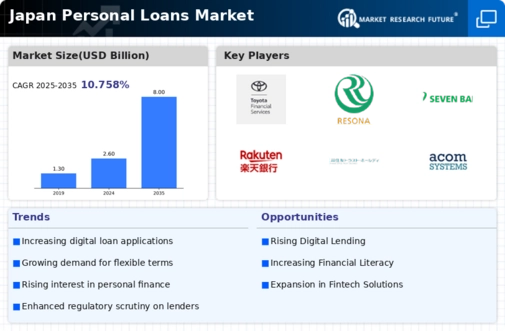Increased Competition Among Lenders
The personal loans market in Japan is witnessing intensified competition among lenders, which is reshaping the landscape of borrowing. As new entrants, including fintech companies, emerge alongside traditional banks, consumers are presented with a wider array of options. This competitive environment is driving lenders to innovate and enhance their product offerings, often resulting in lower interest rates and more favorable terms for borrowers. Recent data indicates that the average interest rate for personal loans has decreased by approximately 2% over the past year, making borrowing more accessible. The personal loans market is thus characterized by a dynamic interplay of competition and consumer choice, which is likely to stimulate growth and improve overall market efficiency.
Rising Consumer Demand for Flexible Financing
In Japan, there is a growing consumer demand for flexible financing options, which is significantly impacting the personal loans market. As individuals seek to manage their finances more effectively, the desire for loans that offer customizable repayment terms and lower interest rates has surged. Recent data suggests that around 45% of borrowers prioritize flexibility when choosing personal loans, indicating a shift in consumer preferences. This trend is further fueled by the increasing cost of living and the need for financial support in various life events, such as education, home renovations, or medical expenses. The personal loans market is responding to this demand by offering tailored products that cater to diverse financial needs, thereby enhancing customer satisfaction and loyalty.
Technological Advancements in Financial Services
The personal loans market in Japan is experiencing a notable transformation due to rapid technological advancements. Innovations such as artificial intelligence and machine learning are streamlining the loan application process, enhancing customer experience, and reducing operational costs for lenders. As of November 2025, approximately 60% of personal loans are processed through digital platforms, indicating a shift towards online lending solutions. This trend not only increases accessibility for consumers but also allows lenders to assess creditworthiness more efficiently. The integration of technology in the personal loans market is likely to attract a younger demographic, who prefer digital interactions over traditional banking methods. Consequently, this technological evolution is expected to drive growth in the personal loans market, as more individuals seek quick and convenient financing options.
Demographic Shifts and Changing Borrower Profiles
Demographic shifts in Japan are significantly influencing the personal loans market, as the borrower profile evolves. With an aging population and a growing number of young professionals entering the workforce, the demand for personal loans is diversifying. Younger borrowers, who are often tech-savvy and financially literate, are seeking loans for various purposes, including education and entrepreneurship. Conversely, older borrowers may require loans for healthcare or retirement planning. This changing landscape suggests that the personal loans market must adapt its offerings to cater to these distinct segments. As of November 2025, it is estimated that millennials and Gen Z account for over 30% of personal loan borrowers, highlighting the need for lenders to develop targeted marketing strategies and product features that resonate with these demographics.
Economic Recovery and Increased Consumer Confidence
The personal loans market in Japan is benefiting from a phase of economic recovery, which appears to be fostering increased consumer confidence. As the economy stabilizes, individuals are more inclined to take on debt for personal projects or investments. Recent statistics indicate that consumer confidence levels have risen by approximately 15% in the past year, leading to a corresponding increase in loan applications. This renewed optimism is likely to drive growth in the personal loans market, as consumers feel more secure in their financial situations. Additionally, favorable interest rates and competitive lending options are encouraging borrowers to explore personal loans as a viable financial solution. The interplay between economic conditions and consumer sentiment is crucial in shaping the dynamics of the personal loans market.

















Leave a Comment